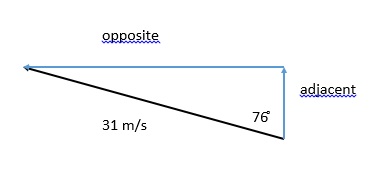Find the vertical and horizontal component?
1 Answer
Explanation:
That line
I have inserted a figure. The 31 m/s vector is shown in black and the 2 components are shown in blue.

The vector is the hypotenuse of the triangle formed by the 2 components and the 31 m/s resultant of the 2 components. Since the hypotenuse will be involved in the calculations, the trigonometry functions we need to be interested in are sine and cosine.
The opposite side is the horizontal component and the adjacent side is the vertical component. Therefore,
You will come to realize that the trig function that would work for many similar questions will be either sine or cosine. My way to find which is the right function for the occasion is to ask "if the angle were zero (or sometimes 90), which function would give the proper result".
If you asked yourself that question on this problem, it would be better in this case to suppose the angle were
I hope this helps,
Steve

